
Heavitree Gap Police Station is a historic building within the Heavitree Gap Police Station Historical Reserve. It is located on the southwestern side of Heavitree Gap in Alice Springs in the Northern Territory of Australia.


Heavitree Gap Police Station is a historic building within the Heavitree Gap Police Station Historical Reserve. It is located on the southwestern side of Heavitree Gap in Alice Springs in the Northern Territory of Australia.

The area was declared as a conservation reserve under Section 12 of the Territory Parks and Wildlife Commission Act of 30 June 1978 based on its historic values. The reserve is significant because of its connection to early policing in Central Australia, European settlement and early frontier contact between Aboriginal and European people.
The first police camp in Alice Springs was established in 1879 at the Alice Springs Telegraph Station. In 1879, Mounted Constable William Wilshire moved the camp via wagon to Heavitree Gap.
In 1904, the buildings were proclaimed to be a public gaol under the Prison Act 1869. [1]
The condition of the site had deteriorated by the early 1960s and in 1967 work was undertaken to reconstruct it.
It is currently occupied by a caretaker. [2]
It was listed on the Northern Territory Heritage Register on 15 February 1994. [3]
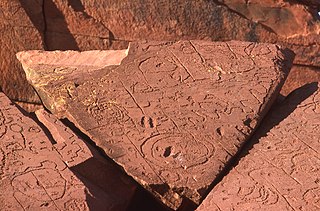
The protected areas of the Northern Territory consists of protected areas managed by the governments of the Northern Territory and Australia and private organisations with a reported total area of 335,527 square kilometres (129,548 sq mi) being 24.8% of the total area of the Northern Territory of Australia.
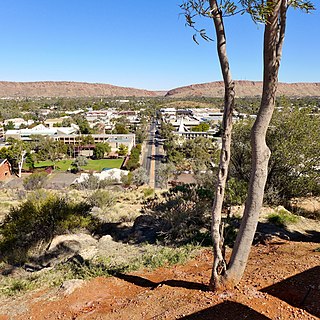
Alice Springs is a town in the Northern Territory, Australia; the third largest settlement after Darwin and Palmerston. The name Alice Springs was given by surveyor William Whitfield Mills after Alice, Lady Todd, wife of the telegraph pioneer Sir Charles Todd. Known colloquially as "The Alice" or simply "Alice", the town is situated roughly in Australia's geographic centre. It is nearly equidistant from Adelaide and Darwin.

Heavitree is a historic village and former civil parish situated formerly outside the walls of the City of Exeter in Devon, England, and is today an eastern district of that city. It was formerly the first significant village outside the city on the road to London. It was the birthplace of the librarian Thomas Bodley, and the theologian Richard Hooker, and from the 16th century to 1818 was a site for executions within what is now the car park of the St Luke's Campus of the University of Exeter.

The Todd River is an ephemeral river in the southern Northern Territory, central Australia. The origins of the Todd River are in the MacDonnell Ranges, where it flows past the Telegraph Station, almost through the centre of Alice Springs (Mparntwe), through Heavitree Gap at the southern end of Alice Springs and continuing on for some distance, passing through the western part of the Simpson Desert, as it becomes a tributary of the Hale River, and eventually flowing into Lake Eyre in South Australia.
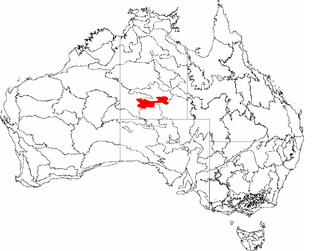
The MacDonnell Ranges, or Tjoritja in Arrernte, is a mountain range located in southern Northern Territory. MacDonnell Ranges is also the name given to an interim Australian bioregion broadly encompassing the mountain range, with an area of 3,929,444 hectares. The range is a 644 km (400 mi) long series of mountains in central Australia, consisting of parallel ridges running to the east and west of Alice Springs. The mountain range contains many spectacular gaps and gorges as well as areas of Aboriginal significance.
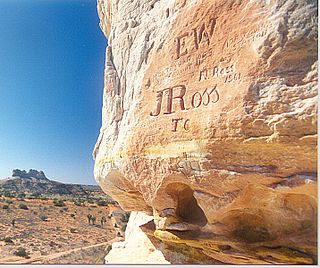
Chambers Pillar is a sandstone formation some 160 km (100 mi) south of Alice Springs in the Northern Territory of Australia.

Henbury Meteorites Conservation Reserve is a protected area in the Northern Territory of Australia located in the locality of Ghan.
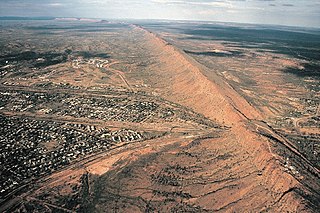
The Heavitree Gap, or Ntaripe in the Arrernte language, is a water gap in the Northern Territory of Australia in the MacDonnell Ranges. It is the southern entrance to the city of Alice Springs and in addition to the Todd River it carries the main road and rail access to the south.
Anna's Reservoir Conservation Reserve is a protected area in the Northern Territory of Australia.
Illamurta Springs Conservation Reserve is a protected area in the Northern Territory of Australia in the locality of Ghan about 42 kilometres (26 mi) south of Hermannsburg and 140 kilometres (87 mi) west of Alice Springs. The southern foothills of the James Range and the permanent spring from which the reserve takes its name are found within the reserve.

Hann Range is a mountain range in the Northern Territory of Australia located in central Australia approximately 120 kilometres (75 mi) north of Alice Springs.

Arltunga is a deserted gold rush town located in the Northern Territory of Australia in the locality of Hart about 110 kilometres (68 mi) east of Alice Springs. It is of major historical significance as the first major European settlement in Central Australia.

The Alice Springs Telegraph Station is located within the Alice Springs Telegraph Station Historical Reserve, four kilometres north of the Alice Springs town centre in the Northern Territory of Australia. Established in 1872 to relay messages between Darwin and Adelaide, it is the original site of the first European settlement in central Australia. It was one of twelve stations along the Overland Telegraph Line.
Owen Springs Station, now known as Owen Springs Reserve is a former pastoral station and now a 1,570-square-kilometre (606 sq mi) nature reserve west of Alice Springs in the Northern Territory of Australia. The Hugh River and Waterhouse Range run through the reserve. It also features the first pastoral homestead built in Central Australia.
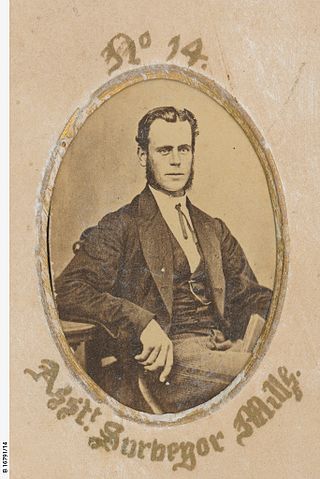
William Whitfield Mills, usually referred to as "W. Whitfield Mills" or "W. W. Mills", was an English surveyor of the Australian Overland Telegraph Line who is best known for naming a waterhole in Central Australia Alice Spring, from which the town of Alice Springs now takes its name. He also named Heavitree Gap as a tribute to his old school in Devon, England.
Parks and Wildlife Commission of the Northern Territory is the Northern Territory Government agency responsible for tasks including the establishment of "parks, reserves, sanctuaries and other land", the management of these and the "protection, conservation and sustainable use of wildlife."
Ryan Well Historical Reserve, formerly Reserve No. 1343, is a protected area in the Northern Territory of Australia located in the locality of Anmatjere about 129 kilometres (80 mi) north of Alice Springs.

Pitchi Richi Sanctuary, located approximately 4 km south of the Alice Springs town centre, is a heritage listed, and now closed, tourist attraction. It was established in the early 1950s by Leo Corbet. The sanctuary is most famous for its collection of works by William Ricketts; it is the largest known collection outside of Ricketts' own sanctuary in the Dandenongs in Victoria.
William Garnet South was a police officer in Alice Springs and Chief Protector of Aborigines. He was also, for a short period, proprietor of the Stuart Arms Hotel in Alice Springs.

John Flynn's Grave Historical Reserve, more commonly referred to as Flynn's Grave is the grave site of John Flynn who was an Australian Presbyterian minister who founded the Australian Inland Mission (AIM) and founding the Royal Flying Doctor Service. The grave, which is now a historical reserve, is located at the base of Mount Gillen on Larapinta Drive in the Alice Springs suburb of Flynn.